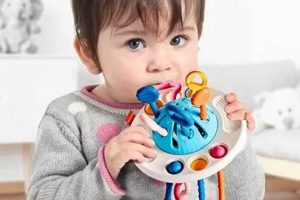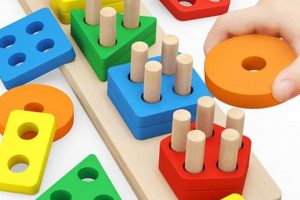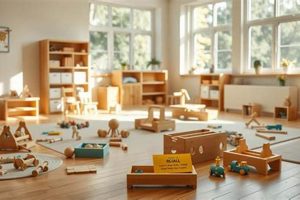Educational materials based on the Montessori method are increasingly available from mass-market retailers. These products aim to provide affordable access to manipulative learning tools that encourage self-directed exploration and development of practical life skills. Examples include wooden puzzles, sorting activities, and fine motor skill development sets designed for specific age ranges, often mimicking materials found in authentic Montessori classrooms.
The availability of such materials through widely accessible channels offers potential benefits for families seeking to incorporate Montessori principles at home, regardless of their proximity to dedicated Montessori schools. This wider distribution can introduce the method’s child-centered learning approach to a larger audience, potentially fostering a broader understanding and appreciation of its educational philosophy. Historically, authentic Montessori materials were primarily available through specialized suppliers, often at a higher price point, making accessibility a significant factor in their adoption.
This increasing availability prompts further discussion regarding the authenticity, quality, and appropriate use of these commercially available materials within a home environment, as well as the importance of understanding the underlying pedagogical principles that guide the Montessori approach.
Tips for Selecting and Utilizing Montessori-Inspired Materials
Choosing and implementing developmentally appropriate materials is crucial for fostering a supportive learning environment aligned with Montessori principles. The following tips offer guidance for parents and educators.
Tip 1: Prioritize Natural Materials: Opt for toys crafted from wood, cotton, or other natural materials. These materials offer sensory richness and durability.
Tip 2: Consider Age Appropriateness: Select materials designed for a child’s specific developmental stage to ensure engagement and prevent frustration.
Tip 3: Focus on Practical Life Skills: Choose materials that encourage activities like pouring, sorting, and fastening, promoting independence and coordination.
Tip 4: Observe the Child’s Interests: Present a variety of materials and observe which ones capture the child’s attention, allowing for self-directed exploration.
Tip 5: Less is More: A curated selection of high-quality materials is preferable to an overwhelming abundance, fostering focused attention and deeper engagement.
Tip 6: Rotate Materials Regularly: Keep the learning environment dynamic by rotating materials periodically, reintroducing familiar items to maintain interest and challenge.
Tip 7: Create a Prepared Environment: Designate a specific area where materials are organized and accessible, promoting independence and a sense of order.
By following these guidelines, caregivers can create an enriching environment that supports children’s natural curiosity and encourages self-directed learning, aligning with the core tenets of the Montessori philosophy.
This understanding of material selection and implementation sets the stage for a deeper exploration of the broader benefits of Montessori-inspired learning.
1. Accessibility
Accessibility, in the context of Montessori-inspired materials, refers to the ease with which families can obtain these resources. Increased availability through mass-market retailers represents a significant shift, potentially broadening the reach of the Montessori method.
- Geographic Availability:
Families in areas without dedicated Montessori schools or specialty stores previously faced limited access to these materials. Retail giants with widespread locations, both physical and online, significantly reduce this barrier. A family in a rural area can now order materials online, eliminating previous geographic constraints.
- Financial Accessibility:
Authentic Montessori materials, often handcrafted and sourced from specialized suppliers, can be prohibitively expensive for many families. Mass-produced versions, while potentially differing in quality, offer a more budget-friendly entry point. This allows more families to experiment with the method, even if they can’t afford a full set of traditional materials.
- Exposure and Awareness:
Placement within mainstream retail settings increases the visibility of Montessori-aligned toys. This exposure can spark curiosity and introduce the educational philosophy to a broader audience who might not have encountered it otherwise. Seeing these toys alongside conventional options normalizes the approach and encourages exploration.
- Simplified Acquisition:
The streamlined purchasing process of large retailers, often integrated with existing shopping habits, simplifies acquisition. Families can add Montessori-inspired toys to their regular online orders or pick them up during routine shopping trips, reducing the effort required to access these resources.
While accessibility through mass retail channels democratizes Montessori principles, careful consideration of material quality and alignment with authentic Montessori pedagogy remains crucial. The increased availability provides an entry point, but informed selection based on developmental appropriateness and educational value ensures effective implementation of the method’s core tenets.
2. Affordability
Affordability plays a crucial role in the accessibility of Montessori-inspired materials, particularly those offered through mass-market retailers. Cost can be a significant barrier to entry for families interested in implementing Montessori principles at home. Examining the affordability factor provides insights into the potential benefits and drawbacks of commercially available Montessori-aligned toys.
- Budget Constraints and Educational Choices:
Many families operate under budget constraints that limit educational spending. The lower price point of mass-produced Montessori-inspired toys compared to those from specialized suppliers makes the method more attainable for a wider range of socioeconomic backgrounds. This expands access to educational materials that might otherwise be financially out of reach, promoting educational equity.
- Cost vs. Quality Considerations:
While affordability is advantageous, it often necessitates trade-offs in material quality. Mass-produced toys may utilize less durable materials or simpler construction compared to handcrafted, premium versions. Parents must weigh the cost savings against potential compromises in longevity and the overall learning experience. For example, a less expensive wooden puzzle might have thinner pieces that are more prone to breakage.
- Supplementation vs. Full Implementation:
Affordable, mass-produced Montessori-inspired toys can effectively supplement a home learning environment. However, they may not fully replicate the quality and comprehensiveness of a complete set of authentic Montessori materials used in a dedicated classroom setting. Families can strategically utilize affordable options to introduce key concepts while recognizing the limitations compared to a fully implemented Montessori curriculum.
- Value and Long-Term Investment:
Evaluating the long-term value of affordable Montessori-inspired materials requires considering durability, educational impact, and the child’s engagement. While the initial cost may be lower, frequent replacements due to breakage can negate the cost savings. Prioritizing materials that offer sustained engagement and learning potential represents a more valuable long-term investment.
The affordability of Montessori-inspired toys offered through mass-market retailers significantly impacts accessibility and adoption. While cost-effectiveness expands the reach of the Montessori method, careful evaluation of quality, durability, and educational value remains essential to ensure a meaningful and enriching learning experience. Balancing cost considerations with educational goals allows families to leverage the benefits of affordable materials while upholding the core principles of Montessori education.
3. Authenticity
Authenticity, regarding Montessori materials available through mass-market retailers, represents a critical consideration for parents and educators. While wider access offers significant benefits, ensuring alignment with core Montessori principles requires careful evaluation of materials. Authenticity influences a toy’s effectiveness in fostering self-directed learning, practical life skills development, and a genuine Montessori experience.
- Material Integrity:
Authentic Montessori materials traditionally emphasize natural, high-quality materials like wood, metal, and fabric. These materials provide sensory richness and durability, contributing to a child’s engagement and the longevity of the learning tools. Mass-produced versions may utilize less durable materials, such as plastic substitutes, potentially compromising the sensory experience and overall quality. For example, a wooden puzzle with smooth, tactile pieces offers a different sensory experience than a plastic equivalent.
- Design Fidelity:
Authentic Montessori materials are meticulously designed to isolate specific skills and concepts, promoting focused learning. Each material has a distinct purpose and is crafted to support a child’s self-discovery. Mass-market adaptations may deviate from these design principles, incorporating extraneous features or simplifying functionalities, potentially diminishing their educational effectiveness. A simplified version of a pouring activity, for instance, might not offer the same level of precision and control as the original design.
- Pedagogical Alignment:
Authenticity extends beyond the physical materials to encompass the underlying pedagogical principles. Montessori education emphasizes self-directed learning, practical life skills, and sensory exploration. Mass-market toys labeled “Montessori-inspired” might not fully adhere to these principles, potentially misrepresenting the method’s core tenets. A toy marketed as promoting fine motor skills might lack the self-correcting mechanisms or the clear progression of difficulty characteristic of authentic Montessori materials.
- Control of Error:
A hallmark of authentic Montessori materials is the incorporation of “control of error.” This feature allows children to self-assess their progress and identify mistakes independently, fostering self-reliance and problem-solving skills. Mass-produced versions may not include this crucial element, limiting the opportunity for self-correction and potentially hindering the development of these important skills. A puzzle with a self-correcting mechanism, for instance, allows a child to recognize and rectify placement errors independently.
Evaluating authenticity when selecting Montessori-inspired toys available through mass-market retailers is vital for ensuring alignment with the method’s educational philosophy. While these retailers offer increased accessibility and affordability, discerning consumers must consider material quality, design fidelity, and pedagogical alignment to maximize the educational benefits and provide a genuinely Montessori-inspired learning experience. Prioritizing authenticity ensures that these materials effectively support children’s self-directed learning, practical life skills development, and overall development in line with Montessori principles.
4. Quality
Quality represents a critical factor when evaluating Montessori-inspired materials, particularly those available through mass-market retailers like Target. While accessibility and affordability are advantageous, prioritizing quality ensures that these materials effectively support children’s development and align with the core principles of Montessori education. Quality encompasses material durability, design integrity, safety, and overall educational value.
- Durability and Longevity:
Montessori materials are intended for repeated use and manipulation. High-quality materials, often crafted from durable wood, metal, or fabric, withstand the rigors of frequent handling, ensuring longevity and minimizing the need for replacements. Conversely, lower-quality materials may break or deteriorate quickly, compromising the learning experience and potentially posing safety hazards. A sturdy wooden puzzle, for example, will withstand repeated assembly and disassembly better than a flimsy cardboard version.
- Design and Functionality:
Quality extends beyond material durability to encompass design integrity and functionality. Well-designed Montessori materials are purposeful and support specific learning objectives. They often incorporate self-correcting mechanisms that allow children to identify and rectify errors independently, fostering self-reliance. Poorly designed materials may lack these features, hindering the development of these essential skills. A set of stacking cups, for instance, should be designed to fit together precisely, allowing the child to self-assess their accuracy.
- Safety and Non-Toxicity:
Safety is paramount, especially for materials intended for young children. High-quality Montessori materials utilize non-toxic paints, finishes, and materials, ensuring children’s well-being during exploration and play. Checking for certifications and adherence to safety standards provides assurance and minimizes potential risks. Wooden toys should be finished with non-toxic, child-safe paints and sealants.
- Educational Value and Engagement:
Ultimately, the quality of Montessori-inspired materials is measured by their educational value and ability to engage children in meaningful learning experiences. High-quality materials are designed to isolate specific skills, promote concentration, and encourage self-directed exploration. Evaluating a material’s educational value involves considering its alignment with Montessori principles, its appropriateness for the child’s developmental stage, and its potential to foster cognitive, social, and emotional growth. A well-crafted sorting activity, for example, can engage a child in developing fine motor skills, color recognition, and logical thinking.
Prioritizing quality when selecting Montessori-inspired materials from mass-market retailers ensures that these accessible resources effectively support children’s development. While affordability remains a factor, understanding the multifaceted nature of qualityencompassing durability, design, safety, and educational valueempowers consumers to make informed decisions that align with the core principles of Montessori education. Investing in high-quality materials, even within a budget, ultimately provides a more enriching and sustainable learning experience for the child.
5. Appropriateness
Appropriateness, in the context of Montessori materials available through mass-market retailers like Target, refers to the alignment of materials with a child’s developmental stage and learning needs. This crucial aspect significantly influences the effectiveness of Montessori-inspired toys in fostering engagement, promoting skill development, and supporting a child’s natural learning progression. Selecting developmentally appropriate materials ensures that challenges are neither too simple, leading to boredom, nor too complex, resulting in frustration. A toddler, for instance, benefits from simple puzzles and practical life activities like pouring and scooping, while an older child might engage with more intricate puzzles, advanced language materials, or activities promoting scientific exploration. Inappropriate material selection can hinder a child’s progress and diminish the value of the Montessori approach.
Developmental appropriateness impacts several key areas within the Montessori framework. Fine motor skills development, for example, progresses from grasping and manipulating simple objects to more refined movements like writing and drawing. Materials should align with this progression, offering graduated challenges that build upon existing skills. Similarly, cognitive development proceeds through stages, from concrete to abstract thinking. Materials should support this transition by providing concrete, hands-on experiences that gradually introduce more abstract concepts. For instance, a young child might learn about fractions using concrete manipulatives, while an older child might work with symbolic representations. Understanding these developmental milestones allows for the selection of materials that optimally challenge and engage the child, maximizing learning potential.
Practical application of this understanding requires careful consideration of age recommendations, skill level, and the child’s individual interests. Observing a child’s engagement with materials provides valuable insights into their current developmental stage and learning preferences. While age recommendations offer a general guideline, flexibility and responsiveness to individual needs are essential. A child might excel in one area while requiring additional support in another. The ability to adapt and adjust material selection based on these observations ensures that the learning environment remains stimulating, supportive, and aligned with the child’s unique developmental trajectory. This individualized approach, central to the Montessori philosophy, optimizes the effectiveness of Montessori-inspired materials and fosters a positive and productive learning experience.
Frequently Asked Questions about Montessori-Inspired Materials from Mass Retailers
This section addresses common inquiries regarding Montessori-inspired materials available through large retail chains, aiming to provide clarity and guidance for parents and educators.
Question 1: Do Montessori-inspired toys from mass retailers adhere to authentic Montessori principles?
While these toys often draw inspiration from Montessori principles, they may not fully replicate the quality and pedagogical precision of authentic Montessori materials. Careful evaluation of material quality, design, and alignment with Montessori philosophy is essential.
Question 2: Are these commercially available materials suitable for use in a home environment?
These materials can effectively supplement a home learning environment, offering opportunities for practical life skills development and sensory exploration. They can be particularly valuable for families without access to dedicated Montessori schools or who are exploring the Montessori method.
Question 3: How can one discern the quality of Montessori-inspired toys from mass retailers?
Prioritize natural materials, durable construction, and designs that promote self-directed learning and control of error. Look for materials that align with a child’s developmental stage and avoid overly complex or simplistic designs.
Question 4: What are the key differences between authentic Montessori materials and mass-produced versions?
Authentic Montessori materials are typically handcrafted from high-quality, natural materials and meticulously designed to isolate specific skills. Mass-produced versions may utilize less durable materials and deviate from these precise design principles, potentially impacting their educational effectiveness.
Question 5: Can these more accessible materials provide a comparable learning experience?
While offering valuable learning opportunities, especially for introducing Montessori concepts, mass-produced versions may not fully replicate the comprehensive and nuanced learning experience provided by a complete set of authentic Montessori materials within a dedicated classroom setting.
Question 6: How can parents effectively utilize these materials to support their child’s development?
Create a prepared environment where materials are organized and accessible. Observe the child’s interests and engagement, offering choices and allowing for self-directed exploration. Rotate materials regularly to maintain interest and present new challenges.
Discernment and thoughtful selection are crucial when choosing Montessori-inspired materials from mass retailers. Prioritizing quality, developmental appropriateness, and alignment with Montessori principles ensures that these accessible resources effectively support a child’s learning journey.
Further exploration of specific Montessori materials and their applications within various developmental stages can provide additional guidance for parents and educators.
Montessori Toys Target
Exploration of Montessori-aligned materials available through mass-market retailers reveals significant potential for expanding access to this educational approach. Key considerations include affordability, which broadens accessibility but necessitates careful evaluation of quality and authenticity. Prioritizing materials that reflect core Montessori principles, such as natural materials, self-directed learning, and control of error, maximizes educational value. Developmental appropriateness remains paramount, ensuring alignment with a child’s learning needs and promoting optimal engagement. While these commercially available options offer a valuable entry point to Montessori education, discerning selection based on these criteria ensures a meaningful and enriching learning experience.
The increasing availability of Montessori-inspired toys through widespread retail channels represents a significant step towards democratizing access to this influential educational philosophy. Thoughtful consideration of material selection, informed by an understanding of Montessori principles and child development, empowers families and educators to harness the potential of these accessible resources effectively. Continued exploration and discussion regarding the appropriate use and adaptation of Montessori principles within diverse learning environments will further contribute to the evolution and accessibility of this impactful approach to education.







